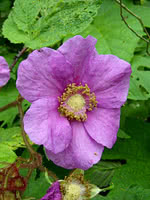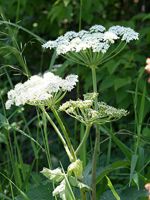Mon-Fri 9am - 5pm Mountain time
Flowering Raspberry vs Cow Parsnip
Rubus odoratus
Heracleum maximum
NOT AVAILABLE THIS SEASON - MIGHT RETURN
CUSTOM GROW
The Flowering Raspberry is an ornamental shrubby plant that blooms with fragrant light purple flowers throughout the summer and has a large, decorative foliage of bright green leaves. The flowers resemble that of a wildrose, and the foliage turns a bright yellow in the fall. This cultivar produces small red raspberries, similar to that of a thimbleberry, but the fruit is mostly tasteless.
The Flowering Raspberry, also known as Virginia Raspberry or Purple-Flowered Raspberry, makes a great hedge plant and is a good choice for attracting birds to your yard.
Cow Parsnip is a native perennial wildflower known for its tall growth, very large leaves, and broad clusters of white flowers. The abundant blossoms provide nectar and pollen for a wide variety of pollinators, including bees and butterflies. Birds and small mammals feed on its seeds, while the foliage serves as a larval host for certain butterfly species.
Cow Parsnip is often among the first native perennials to establish in disturbed or open sites. It typically grows in moist meadows, along streambanks, forest edges, and roadsides. Although usually a short-lived perennial or biennial, it readily self-seeds and maintains strong populations where conditions are favorable.
Cow Parsnip is the only native Heracleum in North America and should not be confused with the highly invasive Giant Hogweed (H. mantegazzianum).
Note: The sap of the Cow Parsnip can cause phytodermatitis when exposed to ultraviolet light (sunlight). This can cause rashes or even burns. Care should be taken if pruning or handling this plant.
Flowering Raspberry Quick Facts
Cow Parsnip Quick Facts
Toxicity: sap causes skin irritation

